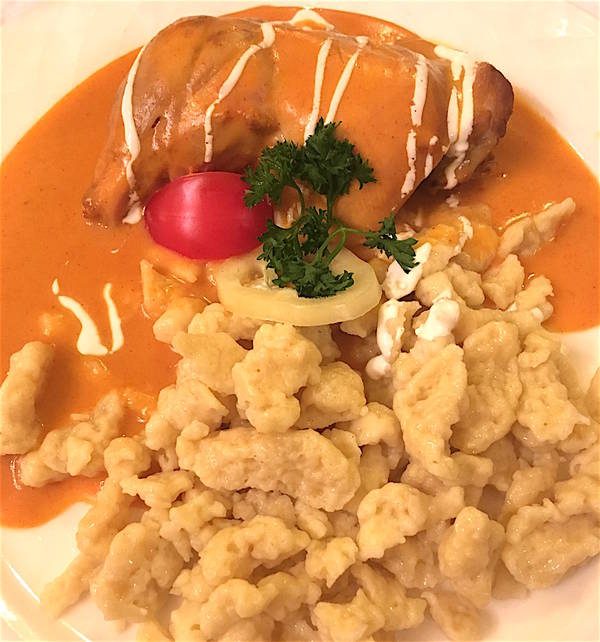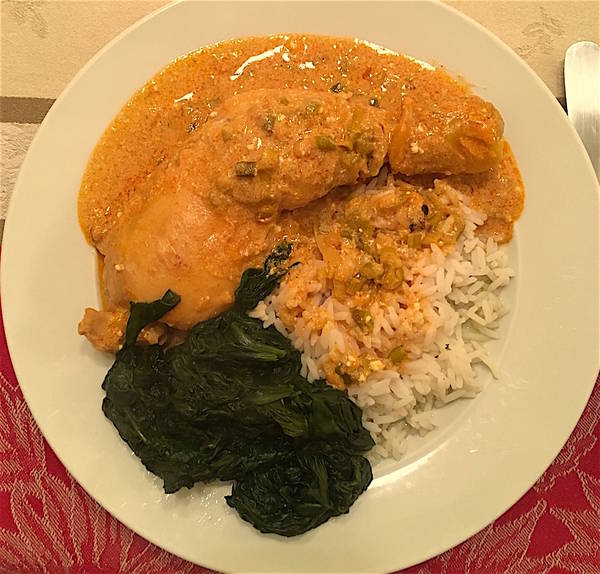István Czifray was the nom de plume of István Czövek, master chef at the court of the Palatine Joseph, Habsburg governor of Hungary in the early 19th century. Czifray’s book of recipes and household tips (including instructions for making perfumes and pomades) first appeared in 1816. Soon to be entitled Magyar Nemzeti Szakácskönyve (Hungarian National Cookbook), it went into numerous editions, the last coming out in 1888. It is an important landmark in the annals of Hungarian culinary history. Czifray includes a recipe for the signature Hungarian dish of paprika chicken (paprikás csirke). Since we had recently eaten this dish at Kárpátia, and old-fashioned restaurant in central Budapest whose opulent interior decoration is a sort of pastiche of the Hungarian Parliament and the Matthias Church, and where tourists’ eardrums are cheerfully assaulted by the squealing of a gypsy band, we were curious to see how Czifray’s recipe measured up.
The Kárpátia version of the dish looked like this:

Ours wouldn’t look quite like that. We weren’t planning to make galuska (that’s a subject for another post). The key thing to get right was the sauce.
Here is Czifray’s recipe:
“Pluck and draw a pair of young chickens. Wash them and cut into equal-sized pieces. Lightly salt these. Finely chop an onion and in a copper skillet fry in butter until translucent. Add the chicken pieces and half a dessert spoon of paprika powder. Cover and steam until tender, shaking periodically. Sprinkle with a little flour, add a scant quantity of meat broth and a few spoonfuls of sour cream. Leave to cook on a low heat, carefully skimming off the foam that forms on the surface. Then serve.”
As with many old recipes, it is hazy on precise quantities and gives no information about cooking time. This is something you either have to know from experience or guess.
We didn’t take whole chickens, we began with chicken legs, bought from the butcher that afternoon. Apart from that, we followed the initial instructions, chopping a bunch of spring onions and sautéeing them in a thick wad of butter in a heavy casserole pan (cast iron, we didn’t have copper). Half a dessert spoon of paprika powder sounded rather little, but anyway, we didn’t add much more (maybe a level dessert spoon). It was good-quality paprika, from Kalocsa.
Covering and steaming without the chicken pieces sticking to the pan is tricky. You might want to—as we did—add a little of the meat broth at this stage. We put in a large ladleful of chicken stock that we had made a couple of days previously.
“Cook until tender” is a difficult instruction. How long is that? To be sure that the chicken is cooked through, you want to cook it for at least 45 minutes in total. We reckoned half an hour at this stage, and then a further 20 minutes once the sour cream and flour have gone in.
Sprinkling with flour and then adding sour cream sounded like a recipe for lumpy sauce but oddly enough it worked fine. You really only need a scattering of flour. For “scant quantity” of broth, we read about 200ml. But if it starts drying out, add more. A good tasty stock won’t spoil the dish’s flavour. “A few spoonfuls” of sour cream we interpreted as three or four generously heaped dessert spoons.
We stirred all this in, left the chicken on the lowest flame for a further 20 minutes or so. We didn’t need to skim off any foam—none formed. But we did add a little more salt.
It looked like this (see below). And it was excellent. Even though the sauce didn’t look as flawlessly smooth as Kárpátia’s, in fact it tasted better. The Kárpátia version lacked the spring onions, which really make all the difference.







